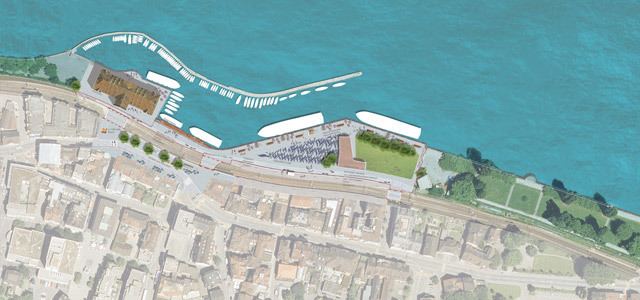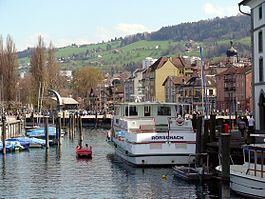Country Area 1.77 km2 | ||
 | ||
Mayor Stadtprasident (list)Thomas Muller SVP/UDC(as of April 2014) | ||
Map of Rorschach, Switzerland
Rorschach is a municipality, in the District of Rorschach in the canton of St. Gallen in Switzerland. It is on the south side of Lake Constance (Bodensee).
Contents
- Map of Rorschach Switzerland
- Rorschachs inkblots test
- Girls in hawaii rorschach live session by bruxelles ma belle 12
- History
- Geography
- Coat of arms
- Demographics
- Transport
- Economy
- Religion
- Heritage sites of national significance
- References

Rorschachs inkblots test
Girls in hawaii rorschach live session by bruxelles ma belle 12
History

Rorschach is first mentioned in 850 as Rorscachun. In 947, Otto I granted the abbot of St. Gall the right to operate markets, mint coins and levy tariffs at Rorschach.
Geography

Rorschach has an area, as of 2006, of 1.8 km2 (0.69 sq mi). Of this area, 7.3% is used for agricultural purposes, while 1.7% is forested. Of the rest of the land, 90.4% is settled (buildings or roads) and the remainder (0.6%) is non-productive (rivers or lakes).
The municipality is the capital of the Rorschach Wahlkreis. It is located on Lake Constance and bordered by the municipalities of Rorschacherberg and Goldach.
Coat of arms
The blazon of the municipal coat of arms is Gules a Garb Or between two Perches urinant.
Demographics
Rorschach has a population (as of 31 December 2016) of 9,408. As of 2007, about 43.7% of the population was made up of foreign nationals. Of the foreign population, (as of 2000), 156 are from Germany, 747 are from Italy, 1,353 are from ex-Yugoslavia, 103 are from Austria, 329 are from Turkey, and 740 are from another country. Over the last 10 years the population has decreased at a rate of -5%. Most of the population (as of 2000) speaks German (76.0%), with Italian being second most common ( 5.3%) and Serbo-Croatian being third ( 4.4%). Of the Swiss national languages (as of 2000), 6,572 speak German, 38 people speak French, 462 people speak Italian, and 13 people speak Romansh.
The age distribution, as of 2000, in Rorschach is; 885 children or 10.2% of the population are between 0 and 9 years old and 991 teenagers or 11.5% are between 10 and 19. Of the adult population, 1,224 people or 14.2% of the population are between 20 and 29 years old. 1,351 people or 15.6% are between 30 and 39, 1,190 people or 13.8% are between 40 and 49, and 1,013 people or 11.7% are between 50 and 59. The senior population distribution is 786 people or 9.1% of the population are between 60 and 69 years old, 751 people or 8.7% are between 70 and 79, there are 402 people or 4.6% who are between 80 and 89, and there are 54 people or 0.6% who are between 90 and 99.
In 2000 there were 1,848 persons (or 21.4% of the population) who were living alone in a private dwelling. There were 1,916 (or 22.2%) persons who were part of a couple (married or otherwise committed) without children, and 3,925 (or 45.4%) who were part of a couple with children. There were 555 (or 6.4%) people who lived in single parent home, while there are 42 persons who were adult children living with one or both parents, 38 persons who lived in a household made up of relatives, 96 who lived household made up of unrelated persons, and 227 who are either institutionalized or live in another type of collective housing.
In the 2007 federal election the most popular party was the SVP which received 26.1% of the vote. The next three most popular parties were the SP (23.6%), the CVP (22.9%) and the FDP (13.9%).
In Rorschach about 55.3% of the population (between age 25-64) have completed either non-mandatory upper secondary education or additional higher education (either university or a Fachhochschule). Out of the total population in Rorschach, as of 2000, the highest education level completed by 2,313 people (26.7% of the population) was Primary, while 2,915 (33.7%) have completed their secondary education, 704 (8.1%) have attended a Tertiary school, and 582 (6.7%) are not in school. The remainder did not answer this question.
The historical population is given in the following table:
Transport
Train lines link the city to St. Gallen, St. Margrethen, and Romanshorn. A rack railway, the Rorschach-Heiden-Bahn, leads to Heiden (800m a.s.l.). In 1856, the station became the terminus of the line Zurich-St. Gallen. Formerly, train carriages were transported over Lake Constance and thus it was possible to reach Heiden from Frankfurt or Berlin without changing trains.
The highway A1 runs close to the south of Rorschach, but the town does not have its own junction. The highway leads towards Sankt Gallen to the west and Sankt Margrethen to the east.
Rorschach also has a harbour served by passenger ferries. These travel to nearby towns on the Swiss and German sides of the lake.
A number of hiking trails either start or end in Rorschach. These include the Via Jacobi (one of the routes of the Way of St. James), the Alpenpanoramaweg to Geneva, and the Rheintaler Höhenweg to Sargans.
Economy
As of 2007, Rorschach had an unemployment rate of 3.59%. As of 2005, there were 30 people employed in the primary economic sector and about 3 businesses involved in this sector. 1,188 people are employed in the secondary sector and there are 103 businesses in this sector. 3,417 people are employed in the tertiary sector, with 467 businesses in this sector.
As of October 2009 the average unemployment rate was 6.3%. There were 558 businesses in the municipality of which 107 were involved in the secondary sector of the economy while 451 were involved in the third.
As of 2000 there were 1,878 residents who worked in the municipality, while 2,486 residents worked outside Rorschach and 4,218 people commuted into the municipality for work.
Religion
From the 2000 census, 4,033 or 46.6% are Roman Catholic, while 1,868 or 21.6% belonged to the Swiss Reformed Church. Of the rest of the population, there are 9 individuals (or about 0.10% of the population) who belong to the Christian Catholic faith, there are 407 individuals (or about 4.71% of the population) who belong to the Orthodox Church, and there are 187 individuals (or about 2.16% of the population) who belong to another Christian church. There is 1 individual who is Jewish, and 1,106 (or about 12.79% of the population) who are Islamic. There are 68 individuals (or about 0.79% of the population) who belong to another church (not listed on the census), 652 (or about 7.54% of the population) belong to no church, are agnostic or atheist, and 316 individuals (or about 3.65% of the population) did not answer the question.
Heritage sites of national significance
The former granary (Kornhaus) at Hauptstrasse 58 and the former Benedictine Abbey of Mariaberg (now the Kantonales Lehrerseminar) at Seminarstrasse 27 are listed as Swiss heritage sites of national significance.
In town, sights include the lake promenade, an aviation museum in Altenrhein as well as the castles of St. Anna, Wartensee, Sulzberg and Wartegg.
Additionally, the whole town of Rorschach and the Schlosslandschaft Rorschach / Alter Rhein, a number of castles in a region along the Rhine river, are designated as part of the Inventory of Swiss Heritage Sites. The Schlosslandschaft is shared between Berg, Goldach, Mörschwil, Rheineck, Rorschacherberg, St. Margrethen, Steinach, Thal and Tübach.
